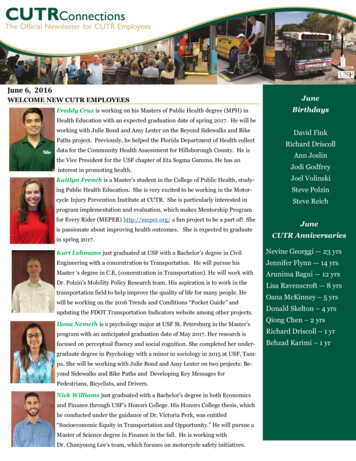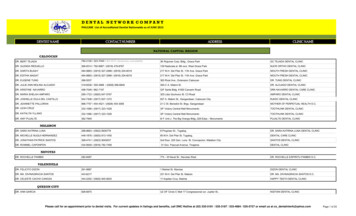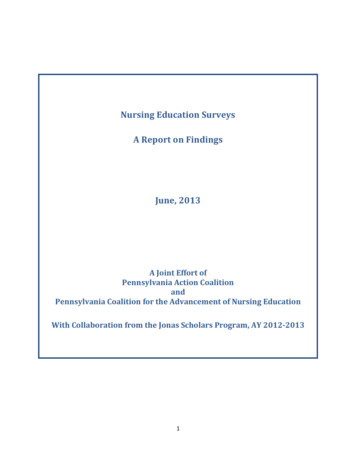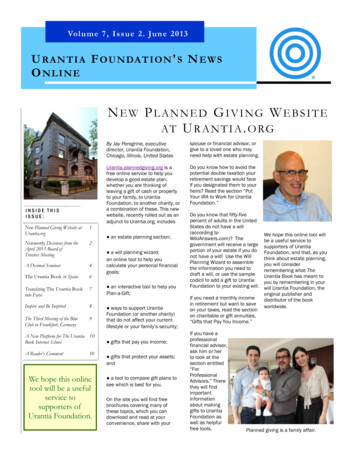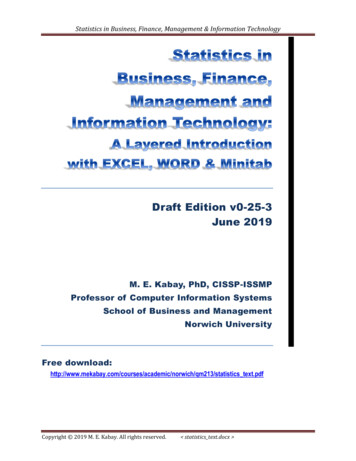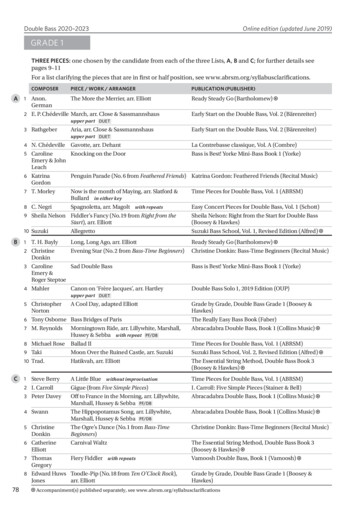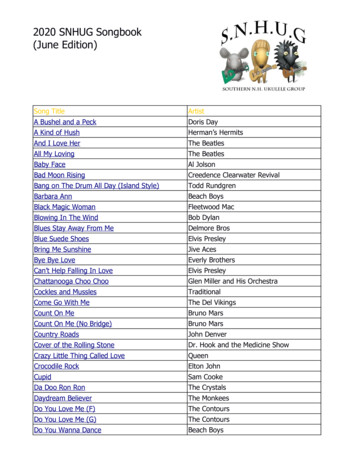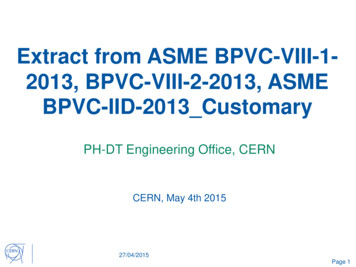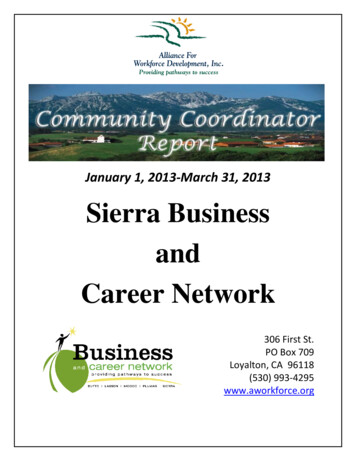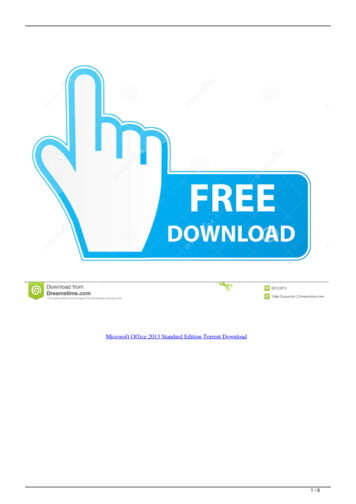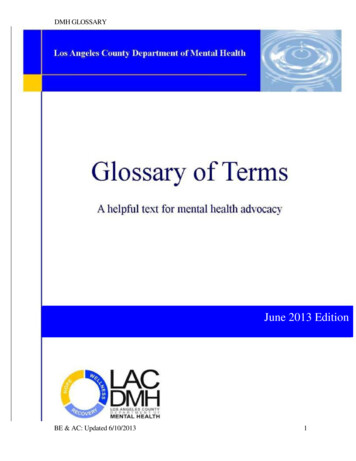
Transcription
DMH GLOSSARYJune 2013 EditionBE & AC: Updated 6/10/20131
DMH GLOSSARYLos Angeles County Department of Mental HealthGlossary of TermsThis glossary was created under the Community and Government RelationsDivision (CGRD) of the Los Angeles County Department of Mental Health. Beginningin 2008, as a project of UCLA MSW Intern, Stephanie Bartsch, this document hassince then been updated by the following MSW interns:Kimberly Ngiangia, UCLAAlicia Powell, CSULBAlex Raskin, UCLANadia Wright, USCSuzanne Cheatham, USCRachel Gannon UCLAAnastasia V. Lebedeva, CSUNLuis E. Quintanilla, UCLAAntonio Chapa, USCBetzabel Estudillo, UCLAAsja Hall, CSUDH20092010201120122013This text was envisioned to help persons interested in mental health advocacy tounderstand the terminologies and concepts used within the mental health system andto have a working knowledge of certain policies that affect the system. The definitionsin this text are taken from various sources including existing documents, personnel, andcommittees.The 2013 edition was planned to include the Spanish translation of the termsbut the translation has not yet been completed so an update will be posted at a latertime. Our gratitude goes to Sr. Mary Yun, MSW and Luis Orozco, LCSW of theCommunity and Government Relations Division for their assistance in editing thisdocument.This is a living document and it is open to the addition/deletion of terms orfeedback. Please send comments or suggestions to Adrienne Cedro Hament, LCSW atahament@dmh.lacounty.gov.BE & AC: Updated 6/10/20132
DMH GLOSSARYDirectory of Terms#1115 Waiver200% Poverty5150AAB 100 (Mental Health Services Act(See MHSA for definition of MHSA)AB130 (California Dream Act)AB131 (California Dream Act)AB 2034AB3632 (Mental Health Services forSpecial Education)AB540AccessACCESS CenterADAAdvance DirectiveAlternate Crisis Services (ACS)Annual LiabilityAssessmentAssisted Outpatient Treatment (AOT)Association of Community HumanService Agencies (ACHSA)At Risk for SuicideAt Risk Mental State (ARMS)Auditor-ControllerBBlock GrantBenefits EstablishmentBoard letterBOSBundling and Unbundling of ServiceCodesCCalifornia Dream ActCAMPCAOBE & AC: Updated 6/10/2013Cash Flow AdvanceCBOCentral Authorization UnitCCAC (Cultural Competence AdvisoryCommittee)CCCCCHIT.CDADCDECEOCGRDChildren and Youth in StressedFamiliesChildren's Countywide CaseManagementChildren’s System of Care ProgramCiMHClient CongressClient Supportive ServicesCMHDACMHPCCMSCODCOSCommunity CapacityCommunity ClinicCommunity-Designed IntegratedService Management Model (ISM)Community Outreach ServiceCommunity Treatment t Discrepancy ReportContract ProvidersCo-occurring/ComorbidityCoordination of BenefitsCost Reimbursement (CR)County CounselCountywide Resource ManagementCORSCourt Liaison Program (CLP)Credentialing3
DMH GLOSSARYCSACCSSCultureCultural CompetencyCWDDay Treatment RehabilitationDBHDCEODCFSDeferred Action for Childhood Arrivals(DACA)Delegated AuthorityDelegatesDepartment of Health and HumanServices (HHS)Department of State HospitalsDeputy Chief Executive Officer(DCEO)Deputy DirectorDiagnostic and Statistical Manual ofMental Disorders, 4th. Edition, TextRevision Manual (DSM-IV-TRDifferential ResponseDirectly Operated Facility(ies)Duration of Untreated Psychosis (DUP)Division of Empowerment andAdvocacyDMHDrop-In CentersDual DiagnosisEEarly InterventionElectronic Data InterchangeElectronic Health RecordEmpowerment & Advocacy (E&A)EMTEmerging Best PracticesEnhanced Emergency Shelter Program(ESSP)EOBEpisode DataEpisode of CareEPSDTERTBE & AC: Updated 6/10/2013Established Maximum Allowable RateEvidence-based Practices (EBP)Explanation of BalanceFFacilityFamily to FamilyFamily SpecialistFAQFederal Financial ParticipationFee-for-ServiceField Capable Clinical Services (FCCS)First 5 CaliforniaFirst Onset (or First Break)Fiscal IntermediaryFiscal Year (FY)Full Service Partnerships (FSP)Full-time equivalent (FTE)Fully ServedGGatekeeperGrant-in-aidGreater Avenues for Independence(GAIN)”Gross Program BudgetGROWGuide to Procedure CodesHHead of ServiceHealth-based InterventionsHealth CenterHealthcare Common Procedure CodingSystem (HCPCS)Health DeputiesHealth Level Seven (HL7)Healthy FamiliesHealthy Families Procedures ManualHealthyWay LAHIPAAHIPAA Final Security RulesHistorical TraumaHOPEHOTHousing Specialists4
DMH GLOSSARYIICD-9IIHIIMDIMPINN (Innovations)Inappropriately servedIndependent Living Program (ILP)IndigentIndigent Medication Program (IMP)Individuals Experiencing Onset ofSerious Psychiatric IllnessInformation System (IS)Inpatient Fee-for-ServicesIntake PeriodIntegrated PlanIntegrated System (IS)Integrated Clinic ModelIntegrated Mobile Health Team(IMHT)Interagency Placement ScreeningCommitteeInternal Services Department (ISD)International Organization forStandardization (ISO)InterventionInvitation for Bid (IFB)JJuvenile Justice FacilityJuvenile Justice Transition AftercareServices (JJTAS) ProgramKKatie A.LLACDHMLAC PPPLAHSALaura’s LawLCSWLicensed Clinical Social Worker(LCSW)Legal EntityLGBTQIALived ExperienceBE & AC: Updated 6/10/2013Los Angeles Mental Health Plan System(LAMHPS)Los Angeles PublicAdministration/Guardian InformationSystems (LAPIS)LPSMManaged CareManaged Risk Medical InsuranceBoardManagement InquiriesMaster Agreement ListMCAMedi-CalMedi-Cal Eligibility Data System(MEDS)Medical DirectorMedical ModelMedical NecessityMedicareMedicaid WaiversMedicare Fiscal IntermediaryMegan’s LawMember or Title XXI Healthy FamiliesProgram Member (HFPM)METMental Health DisorderMental Health Fee-for-Service(MHFFS)Mental Health ManagementInformation System (MHMIS)Mental Health IntegrationMental Health ProblemMental Health PromotionMFTMHCMental Health Professional ShortageArea (MHPSA)MHPSA DesignationMHSAMHSOACMissionMOUNNAMI5
DMH GLOSSARYNational Council for Prescription DrugPrograms (NCPDP)National Drug Code (NDC)National Provider Identifier (NPI)National Registry of Evidence-basedPrograms and Practices (NREPP)Negotiation PackageNegotiated Rate (NR)Net Program BudgetNon-governmental Agency (NGA)Non-repudiationNon-traditional Mental Health SettingsNotice of Action (NOA)OOCAOffice of Family Advocate (OFA)OMAOffice of the Medical Director (OMD)Office of Multicultural Services (OMS)OnsetOral PresentationOutcome Measures Application (OMA)Outreach & Engagement (O&E)Over Threshold AuthorizationRequest (OTAR)Over-Threshold Specialty MentalHealth ServicesPPAIPAPParent PartnerParityPatient’s Rights OfficePBCPeerPeer BridgerPeer to PeerPeer Model/Peer Support ModelPeer-RunPeer SpecialistPEIPEI PrinciplesPEI ProjectPETPharmacy Benefits Manager (PBM)BE & AC: Updated 6/10/2013PhDPoint of ServicePosttraumatic Stress Disorder (PTSD)Pre-Screen ProposalsPrescription Authorization andTracking System (PATS)PreventionPRCHPrimary CarePrimary ContactPRISMPriority PopulationProbation Camp ServicesProdrome (Prodromal Syndrome)Professional Services UnitProgram HeadProject 50Projects for Assistance in Transitionfrom Homelessness Federal grant funds(PATH)Project Management Methodology(PMM)Promising PracticePromotores de SaludProposition 63 (Prop. 63)Protected Health Information (PHI)Protection and Advocacy Inc (PAI)ProselytizeProviderProvider DirectorPrudent ReservePsyDPsychotropic Medication Authorization(PMA)Psychiatric Advance DirectivePsychiatric Health Facility (PHF)Psychiatric Mobile Response Team(PMRT)Public GuardianPublic Guardian Office (PGO)QQuality Assurance ActivitiesQuality Improvement ProgramQualified Proposer6
DMH GLOSSARYRRCL Certification Unit (RCL)Re-alignment MoneyRecoveryRecovery ModelReferralReligionRendering ProviderRFIRFPRFSRFSQResidential & Bridging ServicesResilienceSSAMHSASchiff Cardenas Crime Prevention ActSchool-based InterventionsSchool FailureSchool Threat Assessment ResponseTeam (START)ScreeningSDSDMHSerious Emotional Disturbance (SED)Serious Mental Illness (SMI) orDisorderService Area Advisory Council (SAAC)Service Area District ChiefService Coordination InquiriesService ExtendersService Function Code (SFC)Service Area NavigatorsService Planning Areas (SPA)Share of CostShort-Doyle ActSingle Fixed Point of Responsibility(SFPR)Skilled Nursing Facility (SNF-STP)Sliding Fee ScheduleSmall CountySMARTSOCSocial InclusionSpecialized Intensive Foster CareSpiritualityBE & AC: Updated 6/10/2013SSDISSIStakeholderState General Fund (SGF)Statement of Qualifications (SOQ)Statement of Work (SOW)Stigma and DiscriminationSubstance AbuseSupportive Residential Programs(Enriched Residential and IMD StepDown)Supportive and Therapeutic OptionsProgram (STOP)System for Treatment AuthorizationRequest (STAR)System Leadership Team (SLT)System of CareTTarasoffTAYTarget CommunityThe Project-Based Operational SubsidyTherapeutic Behavioral Services (TBS)Threshold LanguageTitle IVTitle XXITraditionally Underserved PopulationsTransformationTrauma-Exposed IndividualsTreatment Authorization Request(TAR)TriageUUnderserved/Inappropriately ServedUndocumented YouthUniform Bill-04 (UB-04)Uniform Bill-92 (UB-92)Uniform Method of DeterminingAbility to Pay (UMDAP)Unit of ServiceUnservedUREPUrgent Care Centers (UCCs)7
DMH GLOSSARYWhatever It TakesWRAPWraparoundVVery Small CountyVisionXYZWWelfare and Institutions Code (WIC)Wellness CenterWET#BE & AC: Updated 6/10/20138
DMH GLOSSARY"1115 Waiver" known as the "Bridge to Reform," waiver proposal approved by Centers forMedicare and Medicaid Services (CMS) on November 2, 2010. Through the Section1115 waiver, California aims to advance Medi-Cal program changes (using 10billion dollars) that will help the state transition to the federal health reforms that willtake effect in January 2014. Changes under the waiver involve expanding coveragetoday for those who will become "newly eligible" in 2014 under health care reform,implementing models for more comprehensive and coordinated care for some ofCalifornia's most vulnerable residents, and testing various strategies to strengthenand transform the state's public hospital health care delivery system to prepare for theadditional numbers of people who will have access to health care once health carereform is fully implemented."200% Poverty" references the Federal Poverty Level. 200% poverty means those makingless than twice the poverty level. See diagram below.2013 200% of Federal Poverty LevelPersons in Family/HouseholdGross Annual IncomeGross Monthly Income12345678 22,980 31,020 39,060 47,100 55,140 63,180 71,220 79,260 1,915 2,585 3,255 3,925 4,595 5,265 5,935 6,605SOURCE: Federal Register, 78 FR 5182, 5182 -5183, January 24, 2013"5150" refers to Section 5150 is a section of California's Welfare and Institutions Code(specifically, the Lanterman-Petris- Short Act or "LPS") which allows a qualifiedofficer or clinician to involuntarily confine a person deemed a danger to himself,herself, and/or others[1] and/or gravely disabled. A qualified officer, includes anyCalifornia peace officer, as well as any specifically designated county clinician, canrequest the confinement after signing a written declaration. When used as a term,5150 can informally refer to the person being confined or to the declaration itself.AAB 100 (Mental Health Services Act (See MHSA for definition of MHSA) This billwould require the state, instead of the department, to administer the fund. The billwould authorize continued financial support for mental health programs to comefrom the Local Revenue Fund 2011 in the State Treasury, and would, commencingJuly 1, 2012, require the Controller to distribute to the counties all unexpended andunreserved funds on deposit in the Mental Health Services Fund monthly. The bill,for the 2011-2012 fiscal year, would allocate specified funds in the Mental HealthServices Fund for new purposes: Medi-Cal specialty mental health services, mentalhealth services for special education pupils, and the Early and Periodic Screening,Diagnosis, and Treatment program.BE & AC: Updated 6/10/20139
DMH GLOSSARY“AB130” (California Dream Act) Assembly Bill 130 provides undocumented students,who qualify for AB 540, to receive scholarships derived from non-state funds for thepurpose of attending a credited college (i.e. UC, CSU, and Community College). Thisbill gives undocumented students the ability to receive private scholarships throughthe University.“AB131” (California Dream Act) Assembly Bill 131 provides undocumented students,who qualify for AB 540, to receive state financial aid such as Cal Grants, the Boardof Governors Fee Waiver, and departmental and institutional scholarships.This bill provides access to higher education for low-income undocumented students.Undocumented students who qualify for AB 131 must complete an application, meetdeadlines and follow through with requirements. For more information please visitwww.csac.ca.gov"AB 2034" Assembly Bill No. 2034 provided State general funds that allowed localities toprovide comprehensive, integrated services to adults who have serious mental illnessand who are homeless or at risk of becoming homeless; or who have recently beenreleased from a county jail or state prison; or who are at significant risk ofincarceration or homelessness and do not have access to needed services andsupports. Funding for this program was eliminated from the Fiscal Year 07/08 statebudget in a line-item veto by the Governor. The AB 2034 program was honored as amodel program for individuals with mental illness who are homeless under thePresident's New Freedom Commission. The program's success provided bothinspiration and data on effective practices and helped spur public support for theProposition 63 ballot initiative enacted into law as the Mental Health Service Act of2004 (MHSA)."AB3632 (Mental Health Services for Special Education)" Assembly Bill 3632 alignswith the Individuals with Disabilities Education Act (IDEA), which ensures thatchildren with disabilities are entitled to a free, appropriate public education in theleast restrictive environment. Special education pupils may require mental healthservices in any of the 13 disability categories. To be eligible to receive services, theymust have a current individualized education program (IEP) on file. Services are freeto all eligible students regardless of family income or resources.“AB540”Assembly Bill 540 is a bill that provides California in-state tuition for nonresidentstudents (including legal permanent residents, U.S. citizens and undocumentedstudents) who have attended a CA high school and have received a high schooldiploma or equivalent. Often, undocumented students are referred as AB540 studentsto identify them in a safe manner."Access" is the extent to which an individual who needs mental health services is able toreceive them, based on conditions such as availability of services, cultural andlanguage appropriateness, transportation needs, and cost of services.BE & AC: Updated 6/10/201310
DMH GLOSSARY“ACCESS Center” operates 24 hours/day, 7 days/week as the entry point for mental healthservices in Los Angeles County. Services include deployment of crisis evaluationteams, information and referrals, gatekeeping of acute inpatient psychiatric beds,interpreter services and patient transport."ADA" known as the Americans with Disabilities Act (ADA) was signed into law underPresident George H. W. Bush in 1990. It applies to all private and state-runbusinesses, employment agencies and unions with more than fifteen employees. Thegoal of the ADA is to make sure that no qualified person with any kind of disabilityis turned down for a job or promotion, or refused entry to a public-access area."Advance Directive" Legal documents or statements, including a living will, which arewitnessed and allow an individual to convey in expressed instructions or desiresconcerning any aspect of an individual's health care, such as the designation of ahealth care surrogate, the making of an anatomical gift, or decisions about end-of-lifecare ahead of time. An Advance Directive provides a way for an individual tocommunicate wishes to family, friends and health care professionals, and to avoidconfusion about end-of-life care ahead of time."Alternate Crisis Services (ACS)" provides a comprehensive range of services andsupports for mentally ill individuals that are designed to provide alternatives toemergency room care, acute inpatient hospitalization and institutional care, reducehomelessness, and prevent incarceration."Annual Liability" The Annual Liability, also known as UMDAP liability, is based on asliding scale fee and applies to services extended to the client and dependent familymembers. The annual liability is determined by using the adjusted monthly incomeamount and the number dependent on the adjusted monthly income. A client isresponsible for the annual liability amount or the actual cost of care, whichever isless. The annual liability period runs from the date of the client's first visit throughend of the subsequent eleven calendar months (e.g. An initial liability determinationmade of Jan 5, 2012 would be valid through December 31, 2012) and each 12-monthperiod thereafter during which the client continues to receive services. It is renewedannually, provided the client continues to receive services, with the new 12-monthperiod beginning on the 1st day of the month during which liability was originallydetermined (e.g. using the earlier example, the next annual liability period would runfrom Jan 1, 2013 through December 31, 2013). Note: Admissions and/orreadmissions during the 12-month period do not change the sliding scale fee period.“Assessment” means a professional review and evaluation of an individual’s mental healthneeds and conditions, in order to determine the most appropriate course of treatment,if indicated, and may ascertain eligibility for specific entitlement or mandatedprograms.BE & AC: Updated 6/10/201311
DMH GLOSSARY“Assisted Outpatient Treatment (AOT)” Assisted outpatient treatment is sustained andintensive court-ordered treatment in the community for those most overcome by thesymptoms of severe mental illness. The treatment mechanism is only used until aperson is well enough to maintain his or her own treatment regimen. Serving as abridge to recovery for those released from inpatient facilities as well as an alternativeto hospitalization, assisted outpatient treatment can stop the “revolving door” ofrepeated hospitalizations, jailings, and homelessness“Association of Community Human Service Agencies (ACHSA)” represents more than 75nonprofit community agencies that provide a wide range of child welfare, mentalhealth, and juvenile justice services for vulnerable individuals and families in LosAngeles County. The mission is to promote the role of the private nonprofit sector inmental health and child welfare service delivery and to provide mutual support inpursuit of a more effective community.“At Risk for Suicide” means those individuals or population groups who demonstrate ahigher likelihood than average to commit suicide.“At Risk Mental State (ARMS)” “At Risk Mental State” means the condition ofindividuals who are at risk for developing a psychotic illness and are experiencingsigns or symptoms that are indicative of high risk for psychotic illness. Theseindividuals have not yet been diagnosed with a psychotic illness.“Auditor-Controller” is the department within the County that is responsible for auditingbusiness operations and paying debts.B“Block Grant” In a federal system of government, a block grant is a large sum of moneygranted by the national government to a regional government with only generalprovisions as to the way it is to be spent. This can be contrasted with a categoricalgrant which has more strict and specific provisions on the way it is to be spent. Anadvantage of block grants is that they allow regional governments to experiment withdifferent ways of spending money with the same goal in mind.“Benefits Establishment” is a program of the Comprehensi
Jun 10, 2013 · in 2008, as a project of UCLA MSW Intern, Stephanie Bartsch, this document has since then been updated by the following MSW interns: Kimberly Ngiangia, UCLA Alicia Powell, CSULB 2009 Alex Raskin, UCLA Nadia Wright, USC 2010 Suzanne Cheatham, USC 2011 Rachel Gannon UCLA A
